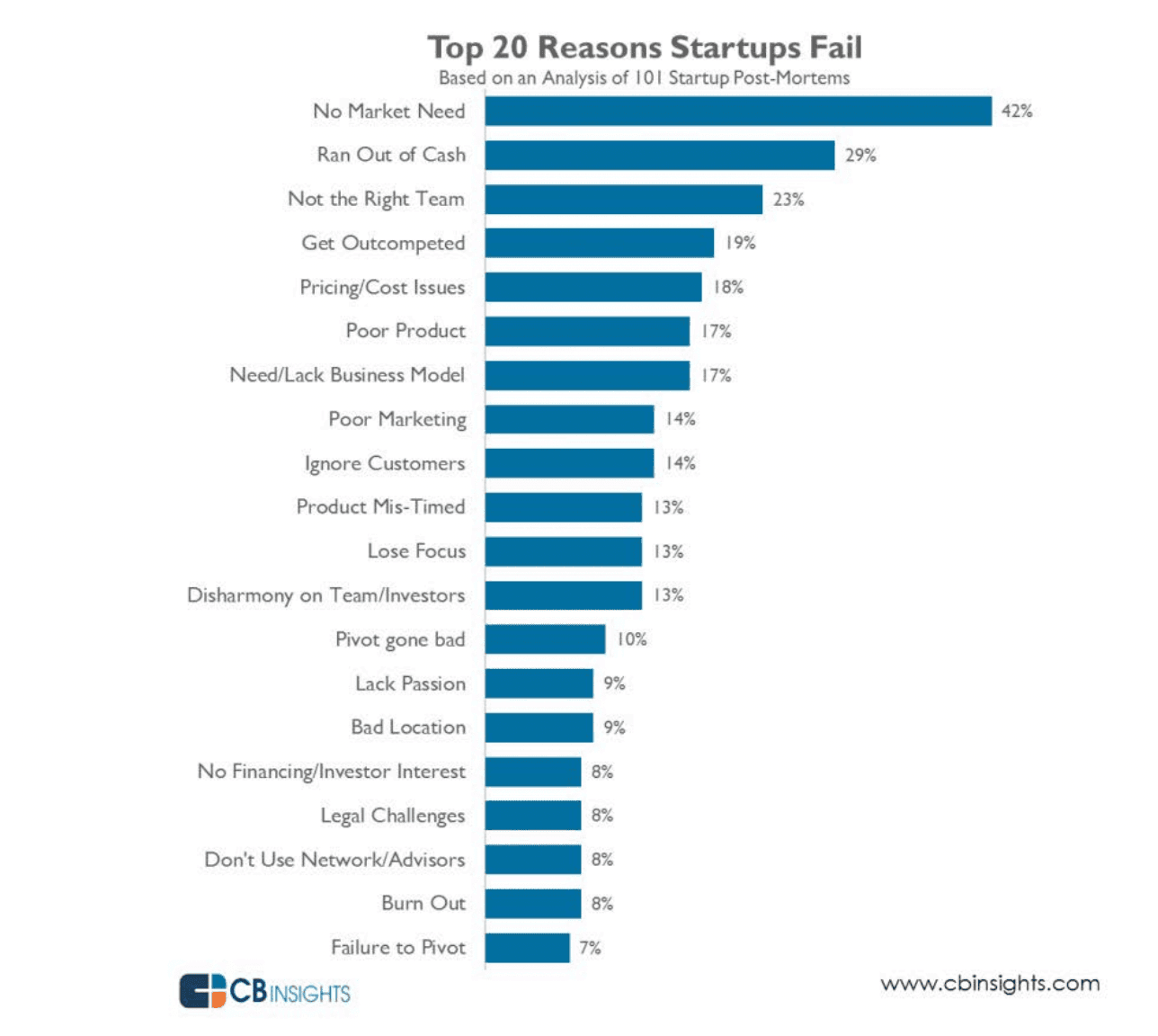Trajectory: Startup: Ideation to Product/Market Fit - Summary and review

🚀 Summary: Trajectory: Startup: Ideation to Product/Market Fit in 30 seconds

Contents
The top 20 reasons why startups fail ❌
Parker analyzed 2564 companies, looking at every seed-funded company on Crunchbase and tracking the last 5+ years.Surprising finds:
Of the failed companies: > 80% lacked a clear CTA, value prop, and pricing page
Combinations models were the fastest to mature - to only pick 1 revenue model was not the most successful way to go
To increase likelihood we do the right thing from the start - it is important we know the main reasons why startups fail. Startups primarily fail due to 1. not serving a market need, 2. running out of cash, or 3. not having the right team.

These are the top 20 reasons for failing in descending order of frequency.
Is your startup ready for venture capital? 💰
The book proposes the following aspects to look at, when determining if you are ready to pitch investors for venture funding.
Team
Idea
Product
Market/customer
Competition
Traction
Timing
Revenue model/finance
IP/Moat
Clear ask
Starting with WHY 🤷❓
Execution is crucial, but working on the right idea is just as important.When building a startup, at all costs, we need to be sure we have a clear why, just like Simon Sinek preaches in the world famous TED talk and book - “Start with Why: How Great Leaders Inspire Action”.
What is a good idea? 💡
There are two main components when evaluating an idea:
Pain level
Willingness to pay.
These components are correlated, but you ideally want your idea to max out both of these. There should be a big existing pain for the customer, and they should be ready to pay for solving it.Your idea will change over time - as you validate and gain more tractionAn idea is different from a product. The idea is a abstract, conceptual and cheap to produce. Whereas, the product is concrete, actionable, and requires execution. Executing is expensive and takes time, so we want to make sure we are building the right product.
2. Pick one primary revenue model - of the 14 possible ones 🎯
When starting out you don’t have the resources to work with multiple revenue models in parallel. So choose one carefully and stay focused. Further down the road one may stack multiple revenue models like Amazon and others have done successfully to generate more revenue. Here are the 14 possible revenue models presented in this book:
Fee for service: typically the model of consulting companies, hard to scale
Commerce: physical goods, wholesale, retail, etc. companies like Amazon
Subscription: forecastable revenue and high multiples, companies like Salesforce, Hubspot, and Spotify
Metered service: pay per use, favors B2B, companies like AWS, Splunk, etc. but also a common model for lots of PLG companies nowadays
Transaction fees/rental: take a cut of each transaction - companies like Kickstarter, Stripe
Productize a service: turn service into a product, offering is typically complex and requires services to deploy, companies like Moz
Combinations: several business models - can happen because you don’t know the ideal model yet, or when reaching scale you can expand revenue, companies like Amazon
Marketplaces: two sided market places that match buyers with sellers, companies like eBay, Alibaba
Lead generation: generate traffic, leads and conversions, companies like Mint.com, NetQuote
Gaming: entertainment and typically “hit driven” business - B2C audience, companies like King (with Candy Crush)
Advertising/search: B2B revenue - advertisers pay, users free, companies like Facebook, Google
New media: Networks with built-in virality, B2C, companies like Snapchat, WhatsApp, Clubhouse
Big data: Monetize data, companies like PatientsLikeMe
Licensing: Pay to use software - pre-subscription era, companies like Microsoft - Microsoft Office license or content licensing
Note that SaaS is not a revenue model, but rather a delivery mechanism. Dave Parker recommends picking a primary and a secondary business/revenue model.
3. The four different ways people buy
How customers can buy. Typically 4 different ways:
Web direct - place the order to buy on the web
Direct - outbound sales - somebody has to talk to the prospect to complete the sale - inside/outside
Indirect/channel - doesn’t generate demand, but rather fulfills it
Retail - distribution, who else could sell the product? BestBuy, etc.
More in-depth talk by Dave Parker himself
Watch The 14 Successful Startup Revenue Models and Key Metrics webinar by Dave Parker himself down below - it’s excellent:
Buy the book: Trajectory: Startup: Ideation to Product/Market Fit 👇
If curious in more, you can buy the full book on Amazon: Print | KindleTrajectory: Startup: Ideation to Product/Market Fit review - what kind of book is it?
If you are an entrepreneur or in an early-stage startup team and want to 1. make sure you are building the right thing, 2. iterate faster, and 3. find the right growth channels - this is an excellent and practical guide based on real experience. Perfect for B2B!
Frequently asked questions (FAQs)
Q: Who is Dave Parker?
Dave Parker is a 5x founder, advisor for dozens of companies, and senior partner at the VC fund Fearless.fund. In his 20+ year career, Dave has shown he can innovate new ideas and scale ventures internationally. So, having been through the journey of ideation to PMF several times, Dave has first hand experience of the topics of this book himself.
Q: Why should you read Trajectory: Startup: Ideation to Product/Market Fit?
An excellent read to find out what a good idea looks like, how it is evaluated by investors, how you can get out of your head and launch, as well as how you can grow and scale once launched.
Q: Who is the ideal reader of Trajectory: Startup: Ideation to Product/Market Fit?
If you are an entrepreneur or in an early-stage startup team and want to 1. make sure you are building the right thing, 2. iterate faster, and 3. experience success - this book is for you.
Want to learn more about growing SaaS companies?

